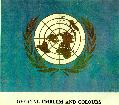|
Flag Etiquette
Flag etiquette and flags have been a symbol of human achievement since ancient times. Flags have been used to lead armies to victory and to claim ownership of vast territories. Flags stir up emotions in us that few other symbols can. Flags have always played an important role in general and maritime signaling and identification.
That piece of cloth with its own exclusive design and colors of your nation, your country, that piece of cloth we simply call a flag is a symbol of who we are, what we believe in and where we belong. It is an accepted fact that people respect the symbolism of the flag, whether it is your country’s flag or another country’s flag. The international protocol and flag etiquette is the same or very similar in all countries throughout the world. Let us begin with the United Nations Flag. Not only is it a beautiful and appropriate design, its symbolism is what makes it meaningful:
Flag etiquette is very strict and it is essential that flag protocols and rules are followed correctly. The following basic flag etiquette applies to all nations:
Etiquette relating to the order of precedence for the flag
1. National flag of the country 2. State flag of the country 3. Military flag of the country (in order of creation date) 4. Other flags of the country The United Nations uses
Your country’s flag should never be flown above another national flag on the same staff as this would suggest superiority or conversely, inferiority of one flag, or Nation over another A country’s flag should never be allowed to drag along the ground
If a country’s flag becomes tattered or faded, it should be removed and replaced with a new flag
Due care and consideration must be taken to ensure that the flag is always flown the correct way up
If a country’s flag is in such a condition that it is no longer a fitting emblem of display, it should be destroyed in a dignified way, preferably by burning in private with all due care and respect
Terminology & Flag Etiquette in Flag Display
1. Hoist - the act or function of raising the flag, as on a rope 2. Half Staff or Half Mast – the flag is hoisted to half of the potential height of the flag pole to denote grief and mourning. This is performed by first raising the flag to the top, then lowering it halfway 3. Distress - denoted by flying the flag upside-down 4. Manner of Hoisting - the flag should be hoisted briskly and lowered ceremoniously 5. Disrespect - no disrespect should ever be shown to the flag 6. Storage & Care - the flag should never be fastened, displayed, used, or stored in such a manner as to permit the flag to be easily torn, soiled, or damaged 7. Defacement - the flag should never have placed upon it, nor on any part of it, nor attached to it any mark, insignia, letter, word, figure, design, picture, or drawing of any nature 8. Order of Priority - your country’s flag should be hoisted first and lowered last 9. Placement - international flag usage forbids the display of the flag of one nation above that of another nation in time of peace. If you have found this information helpful please
On that final note of flag etiquette, please browse the rest of A - Z of Manners and Etiquette, including
International Etiquette
plus
Polish
and
Indian Etiquette
We would like to hear your views on flag protocol and etiquette. To participate, please go to our
Interactive Forum.
|




